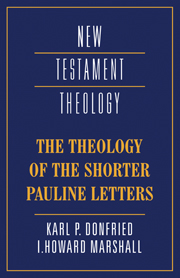15 - The gospel and slavery
Published online by Cambridge University Press: 05 June 2012
Summary
THE BACKGROUND AND SITUATION
Philemon is an authentic letter of Paul written to a Christian called Philemon, who lived in Colosse, together with members of the church that met in his house. It is a ‘communal’ letter addressed to the whole house church, but apart from vs. 1–3 and 24 it is composed throughout as an address to Philemon alone.
The letter was occasioned by the meeting of Philemon's slave, Onesimus, with Paul, who was in prison (whether in Rome or elsewhere is debated); Onesimus was converted by Paul, and the letter is concerned with the ensuing situation.
The situation of Onesimus
It is usually assumed that Onesimus was a runaway slave who had escaped from his master's household, probably with some stolen goods. Somehow he came into touch with Paul, who was in prison, and it was Paul's delicate task to return him to his master. Onesimus could well have been in an unpleasant situation. Although slavery was not always as miserable as it is popularly supposed to have been, the laws were particularly strict against runaway slaves and persons who assisted them, and a master could inflict severe penalties on a slave who was returned to him. A Christian master would not necessarily treat slaves, and especially runaway slaves, any differently. This theory on its own does not explain adequately how Onesimus came to be in prison with Paul, or how Paul had the authority to send him back.
- Type
- Chapter
- Information
- The Theology of the Shorter Pauline Letters , pp. 177 - 191Publisher: Cambridge University PressPrint publication year: 1993

